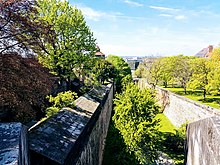Castle bastions
Castle bastions are the names of the bastions to the west and north of the castle in Nuremberg, built from 1538 onwards . The Nuremberg Castle Garden is laid out in them.
location
The dominant Great Bastion is northwest of the castle kemenate. The north-west facing, square building is reinforced by two low bastions ( Faussebrayen ) on the east and west side. The walls were bent ( tenailliert ) on both sides and protected by two further, pentagonal bastions.
The Vestnertorbastei , also called Sweden Bastion, in the east of the Great Bastion, was built above the Vestnertor .
The Tiergärtnertor-Bastei , also called the lower bastion, was built in the southwest, next to the Tiergärtnertor .
In the wall crown of the entire bastion, which is beveled on the side of the ditch, several loopholes for large artillery are cut in such a way that there are no blind spots for the defenders. To the north, the structures are closed by rounded trenches. From the casemate passages inside the bastions, loopholes, several hidden drop doors and stands for smaller artillery allow observation of the trench and the fight against opponents who have penetrated the trench. Small bridges lead to both bastions from the north over the Vestnertor- and Tiergärtnertorgraben.
history
In order to strengthen the castle and city fortifications in line with the further development of artillery , the Maltese-Italian fortress builder Antonio Fazuni built the castle bastions between 1538 and 1545. The hill called Kuhberg north of the Great Bastion consists of the excavation that was left over from the construction work.
In the 16th century bourgeois crossbowmen , the sniper rifles , practiced in the ditch in front of the bastions . A shooting range was reopened in 1994 in the section of the ditch, also known as the Schneppersgraben .
Georg Christoph Eimmart built the first Nuremberg observatory on the Vestnertorbastei , the first public observatory in Germany. In 2007, a memorial column was erected at this point in his memory.
Burggarten
The oldest representation of the imperial castle from 1425 shows a tree garden. Emperor Friedrich III. (1440–1493) had "Hanging Gardens" laid out south of the Palas.
In 1677 gardens were laid out on the bastions. During a stay in Nuremberg in 1855, the Bavarian King Maximilian II bought the areas of the bastions from the city and had the castle garden rebuilt by the gardener Carl Effner . The royal garden was intended as a public green area from the start. After the end of the First World War, it was not opened to the public again until 1929. In August 1942, the Burggarten was badly hit in the first major air raids on Nuremberg. From 1946 the destroyed facility was restored and redesigned. Strictly speaking , the system on the main bastion is called the Rosengarten , the system on the Tiergärtnertor bastion is called Burggarten .
present
The main entrance to the facility is at the castle, next to the pentagonal tower . In the large, upper bastion there is a square rose garden framed by trees. A path leads to the lower bastion to the south. In the further course of the city wall, there is a narrow garden area, which is called the mayor's garden and extends to the Neutor . The second entrance is there. The defensive corridors inside the castle bastions can be viewed on guided tours.
Individual evidence
- ↑ http://www.nuernberg-aha.de/architektur/renaissance/renaissance_burgbasteien.html
- ^ Helge Weingärtner: Castle bastions . In: Michael Diefenbacher , Rudolf Endres (Hrsg.): Stadtlexikon Nürnberg . 2nd, improved edition. W. Tümmels Verlag, Nuremberg 2000, ISBN 3-921590-69-8 , p. 173 ( complete edition online ).
- ^ "Kulturgut" - quarterly magazine of the Germanisches Nationalmuseum; 3rd quarter 2006, p. 2 ( Page no longer available , search in web archives ) Info: The link was automatically marked as defective. Please check the link according to the instructions and then remove this notice.
- ↑ http://naa.net/ain/haben/show.asp?ID=37
- ↑ http://www.th-nuernberg.de/fileadmin/Fachgebiete/wt/Homepage_Neu/Personen/Krcmar/Gedenks%C3%A4ule.pdf ( page no longer available , search in web archives ) Info: The link was automatically defective marked. Please check the link according to the instructions and then remove this notice.
- ↑ Archived copy ( Memento of the original dated December 12, 2015 in the Internet Archive ) Info: The archive link was inserted automatically and has not yet been checked. Please check the original and archive link according to the instructions and then remove this notice.
- ↑ http://www.stadtgraben.nuernberg.de/images/artikel4.pdf
- ↑ http://www.schloesser.bayern.de/deutsch/garten/objekte/nbg_burg.htm
Web links
Coordinates: 49 ° 27 '30.4 " N , 11 ° 4' 29.4" E






